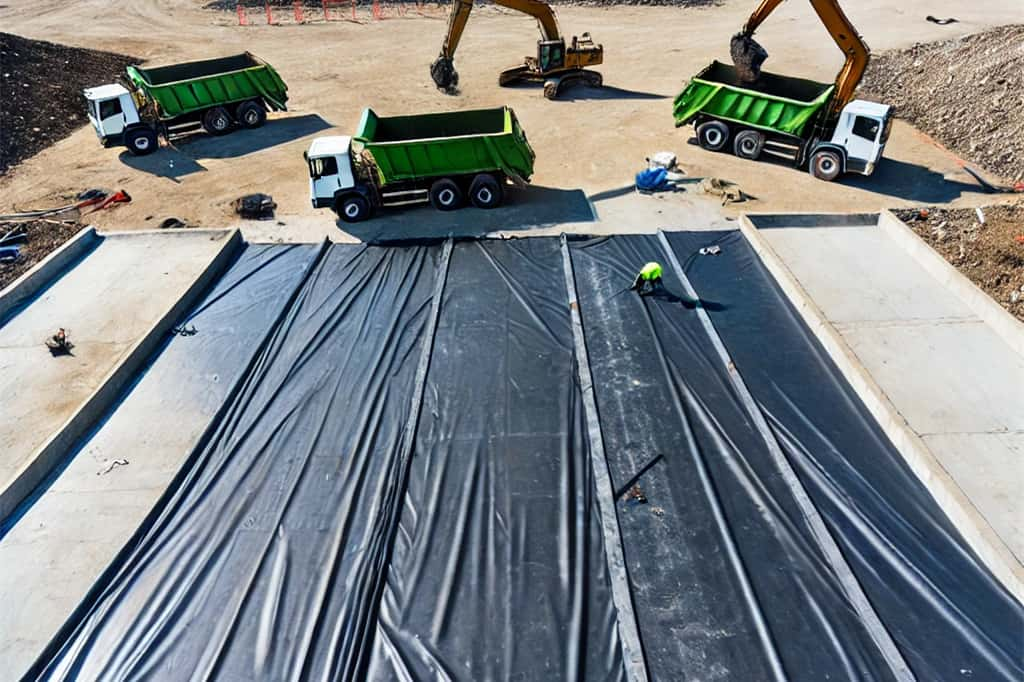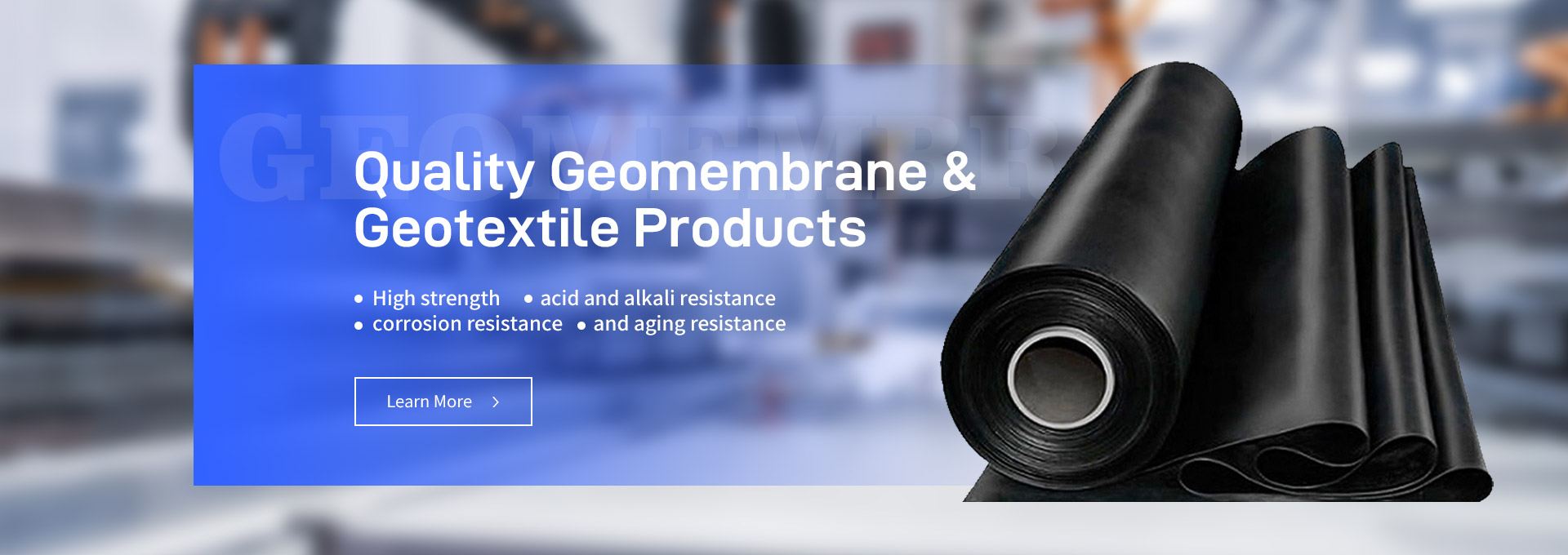With global population growth and the rapid pace of urbanization, waste management has become one of the significant environmental challenges modern society faces. As one of the primary methods of waste disposal, landfills effectively handle solid waste but also come with potential environmental risks. To prevent harmful substances in waste from polluting soil and groundwater, Landfill Geomembrane has emerged as an indispensable solution in modern landfill construction, offering an essential barrier against pollution.

1. Environmental Challenges of Landfills
Landfills may appear to be a simple way to deal with waste, but they pose several environmental risks, primarily in the following areas:
1. Soil and Groundwater Pollution
As waste in landfills breaks down or gets infiltrated by rainwater, it generates leachate, which contains heavy metals, harmful chemicals, and pathogens. If this leachate is not effectively contained, it can seep into the ground, contaminating the soil and groundwater systems. This contamination can not only harm the surrounding ecosystem but also potentially threaten human health.
2. Gas Emissions from Landfills
As waste in landfills decomposes over time, especially organic waste, it releases significant amounts of landfill gases, including methane (CH₄) and carbon dioxide (CO₂). These gases not only contribute to global warming but also pose safety risks such as explosions or fires within landfills.
3. Surface Water Pollution
In landfills without proper lining systems, rainwater may infiltrate the waste, flushing harmful substances into surface water bodies like rivers and lakes. This contamination not only damages local aquatic ecosystems but can also impact agriculture and local water supplies.
4. Aesthetic and Odor Issues
Landfills often face challenges related to aesthetics and odor pollution. Piles of garbage can create an unpleasant landscape, while foul odors affect the quality of life for nearby residents and may even harm local tourism and economic development.
To combat these challenges, modern landfills increasingly adopt advanced lining systems, with Landfill Geomembrane serving as the core technology to address these environmental issues effectively.
2. What is a Landfill Geomembrane and Its Function?
1. What is Landfill Geomembrane?
Landfill Geomembrane is a synthetic membrane made from materials like high-density polyethylene (HDPE) or polypropylene (PP). It offers exceptional impermeability and is widely used in landfills, mining, and water conservation projects. The primary role of a geomembrane is to form an impermeable barrier within a landfill, preventing leachate from seeping into the ground and protecting the soil and water from pollution.
These geomembranes are typically installed at the base or top of landfills, working in conjunction with geotextiles and drainage systems to control leachate and gas emissions.
2. Key Functions of Geomembranes in Landfills
In landfills, Landfill Geomembrane serves multiple environmental protection roles beyond just preventing leakage:
Prevents Leachate Seepage: The main function of the geomembrane is to block the movement of leachate produced by the waste, keeping it from contaminating soil and groundwater. The geomembrane directs leachate into a specialized collection and treatment system for purification.
Gas Containment: Geomembranes also prevent the uncontrolled release of landfill gases, especially methane, a potent greenhouse gas. By covering the landfill with geomembranes, gas can be collected efficiently, sometimes for use in electricity generation or other beneficial purposes.
Enhances Structural Stability: Geomembranes contribute to the overall structural stability of the landfill, preventing issues such as subsidence or landslides, ensuring long-term safety during the landfill’s operation.
Blocks External Water Infiltration: When used as a cover at the top of a landfill, geomembranes prevent rainwater and other external water sources from entering the landfill, reducing the generation of leachate and alleviating pressure on the waste heap.
3. Environmental Benefits of Landfill Geomembranes
1. Excellent Impermeability
The primary feature of Landfill Geomembrane is its outstanding impermeability. Materials like high-density polyethylene (HDPE) and 30 mil PVC geomembrane have a tightly structured molecular composition that forms a robust barrier to block the movement of liquids and gases. Studies show that properly installed geomembranes effectively resist the penetration of hazardous substances such as heavy metals, chemicals, and microbes within landfills.
2. Resistance to Chemical Corrosion
Landfill Geomembranes, especially materials like bituminous geomembrane, possess excellent resistance to chemical corrosion, making them ideal for long-term use in landfills where a wide variety of waste may be present. Landfill leachate can contain acidic, alkaline, or other harmful chemical substances, but the geomembrane’s material remains stable over time, ensuring long-lasting performance.
3. Durability and UV Resistance
Landfills are often exposed to outdoor elements, requiring geomembranes that can withstand long-term exposure to sunlight, rain, and wind. High-quality Landfill Geomembranes have superior UV resistance and durability, maintaining their physical properties under extreme climate conditions. This ensures a lifespan of decades, making them reliable long-term solutions.
4. High Tensile Strength and Tear Resistance
The complex landfill environment requires geomembranes to have high tensile strength and tear resistance to cope with uneven terrain or heavy pressure. 30 mil PVC geomembrane and other HDPE membranes offer not only flexibility but also significant tensile strength, preventing membrane rupture or deformation during installation and operation.
4. Case Studies of Landfill Geomembrane Applications
Landfill Geomembranes have been widely applied in landfills and environmental projects around the world. Below are some typical application cases:
1. Large Urban Landfills
In major cities where the population continues to grow, landfills are required to handle increasing amounts of waste while meeting stricter environmental regulations. To prevent groundwater pollution, these large landfills typically use multi-layered impermeable systems, with Landfill Geomembrane serving as the primary barrier material.
For example, a major city landfill implemented a dual-layer geomembrane system, combined with leachate collection and treatment facilities, successfully controlling leachate and gas emissions. This project significantly reduced the landfill’s environmental risks.
2. Industrial Waste Disposal Sites
Industrial waste often contains more hazardous chemicals, requiring higher standards for impermeable systems. Landfill Geomembrane made from materials like bituminous geomembrane plays a crucial role in ensuring long-term impermeability for industrial waste disposal sites.
In one large industrial waste project, high-density polyethylene geomembranes were used, specially treated to withstand strong acids and alkalis. The geomembrane ensured the safe containment of waste, preventing chemical seepage into the surrounding environment.
3. Environmental Parks and Landscape Projects
Some old landfill sites have been transformed into environmental parks or ecological landscapes. In these scenarios, Landfill Geomembrane not only provides impermeability but also serves to enhance aesthetics and functionality, ensuring long-term containment of waste materials.
For example, a closed landfill was converted into an eco-park, with Landfill Geomembrane covering the top to seal off the landfill and prevent rainwater infiltration. This park now serves as a popular public space, enhancing the local environment.
5. How to Choose the Right Landfill Geomembrane?
When constructing landfills, choosing the right Landfill Geomembrane is crucial. Here are a few key factors to consider:
1.Material Quality:
High-quality materials like HDPE and 30 mil PVC geomembrane are preferred for their impermeability, chemical resistance, and durability.
2.Thickness Selection:
Depending on the size and complexity of the landfill, selecting the appropriate thickness is essential. Larger landfills or those with challenging terrain often require thicker membranes to increase tensile strength.
3.Installation Expertise:
High-quality geomembranes must be paired with professional installation techniques to ensure secure seams and an overall reliable barrier system.
Conclusion
By choosing high-quality Landfill Geomembrane from a reliable manufacturer like us, landfill operators can effectively address environmental challenges while promoting sustainable development. As a leading geomembrane manufacturer, we are committed to providing top-tier solutions that offer exceptional impermeability, durability, and chemical resistance. Whether you need protection against leachate pollution, gas control, or enhanced landfill safety, our products, including advanced options are designed to meet your specific needs. For more information on how we can support your project, don’t hesitate to contact us and discover the right geomembrane solution tailored to your requirements.

